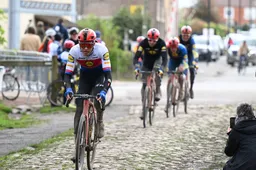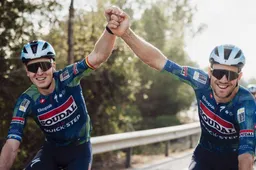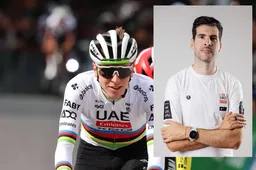Is a safety car essential in cycling? Tre Valli Varesine organizer thinks so: "How else can we ensure safety?"
CyclingTuesday, 03 December 2024 at 15:20

The issue of safety in cycling in 2024, especially after Muriel Furrer's death during the World Championships, has regained priority on the discussion list. While some believe that the sport should 'slow down,' others are putting more responsibility on the sports federations and the UCI. Now, Renzo Oldani, president of the Alfredo Binda Cycling Society, has also suggested a new idea.
Oldani also stopped the Tre Valli Varesine earlier this fall as the person in charge. Riders did not want to continue racing, so the decision was made to cancel the race altogether. Speaking to
Bici, the Italian now discusses a measure he started considering after that edition: a so-called 'safety car' in cycling, as you have in Formula 1.
Read more below the photo.

Riders in the pouring rain around Varese.
Oldani refers to situation with Mas and Bardet: "Then we could have continued"
The person responsible for the October race in question reflects on what such a car could have accomplished that day. Enric Mas and Romain Bardet were at the front and could have been the first to learn about that car. "A safety car, which would have suspended the race from a competitive point of view and allowed the race to overcome the dangerous section with controlled speed, would have allowed them to continue driving, allowing those 10 minutes of heavier rain to pass."
In Formula One, when the safety car is deployed, all time differences in the race are erased, which would be highly unusual in cycling. Still, Oldani is convinced the idea has a future. "Obviously, we cannot introduce the idea tout court; it has to be evaluated and adapted to our needs. It is a factor that needs to be studied, though. It would be a format that everyone could approve of, but we have to discuss it with all the operators, from the UCI to the teams and the riders' union itself."
According to the Italian, it has already been discussed with several organizations, including the UCI. "During the conversation, we clarified our wishes. We often read that organizers must do more and provide more protection. But how do you implement full safety on races of more than 200 kilometers? Leaving everything out of consideration is objectively impossible. Other solutions must be considered."
Read also
IDL-productions

Last year, he was spot on: Lidl-Trek team leader De Jongh names his spring surprise for 2026

Attila Valter on why he left Visma | Lease a Bike: 'If it is what it is after three years, its not going to change'

Still in black, but soon in colorful Lidl-Trek jersey: Juan Ayuso praises new environment

Bouwman not afraid to change at 32 after first disaster year outside of Visma: 'Have to be honest with myself'

Sanremo, a world title and the yellow jersey: Michael Matthews escaped death - and that reignited his spark
Latest Cycling News

How do you replace the departing Kooij, Uijtdebroeks and Benoot? Niermann explains Visma | Lease a Bike's transfers

Soudal Quick-Step won't throw GC ambitions in the bin after Evenepoel's departure: 'Want to win on all terrains'

Participants Tour Down Under 2026 | Brennan, O'Connor, Narváez... Traditional opener draws top names

Jonas Vingegaard won't get a call from Tadej Pogacar

'Get to know 'the man behind Tadej Pogacar's success' at UAE Emirates-XRG
Popular Cycling News

Jonas Vingegaard won't get a call from Tadej Pogacar

Participants Tour Down Under 2026 | Brennan, O'Connor, Narváez... Traditional opener draws top names

How do you replace the departing Kooij, Uijtdebroeks and Benoot? Niermann explains Visma | Lease a Bike's transfers

Soudal Quick-Step won't throw GC ambitions in the bin after Evenepoel's departure: 'Want to win on all terrains'
Latest Comments
- Those events are mental rest for him. Fun, without expectations. *Sagan lost his abilities because he gained weight and got lazy. Pogi will likely retire before that has a chance at happening.Veganpotter14-12-2025
- Ah, the consequences of riding for Israel.Veganpotter11-12-2025
- Pidcock could follow everyone but Pogi while finishing 3rd. No second place rider this season😃Veganpotter16-11-2025
- Now the Palestinian protestors can stop their whining. Trump came to the rescue. So they can now STFU and go back to waving the rainbow flags.raufus15-10-2025
- Cracked the code lol. If it was that easy to 'crack the code' jonny Vegas would be charging up the Kwaremont giving Pog a dose of his medicine. Evenepoel can't match pog on a climb and neither can mvdp. Anything with a half difficult climb and Pog smashes the field. Even on flat(ish)parcours like Roubaix it came down to a mistake and crash by pog to definitively crown mvdp. MSR is the only one that Pog probably won't win.kevpt10-10-2025
- We've seen this movie before. I think Pogacar is doping.DeadBlow10-10-2025
- 👍Bea08-10-2025
- 👌🏻Bea08-10-2025
- What the data doesn't show is how much of an effect drafting had for evenepoel. Pogacar went with del toro at 100km whilst Evenepoel was still in the bunch. Despite the bike changes he still had a lot of assistance getting back to the bunch. Pogacar then rode 60km solo whilst evenepoel rode with Healy/Skjelmose until going solo in thd last 10-15km. Thats ~20% less power / energy requirements for 45-50km. Apples and oranges...kevpt30-09-2025
- 👏👏Bea24-09-2025
Loading


